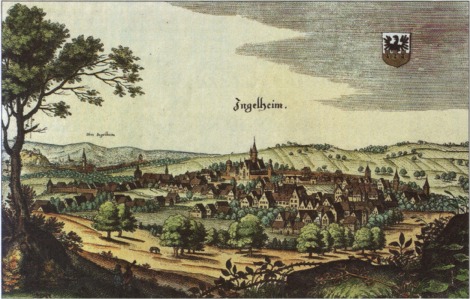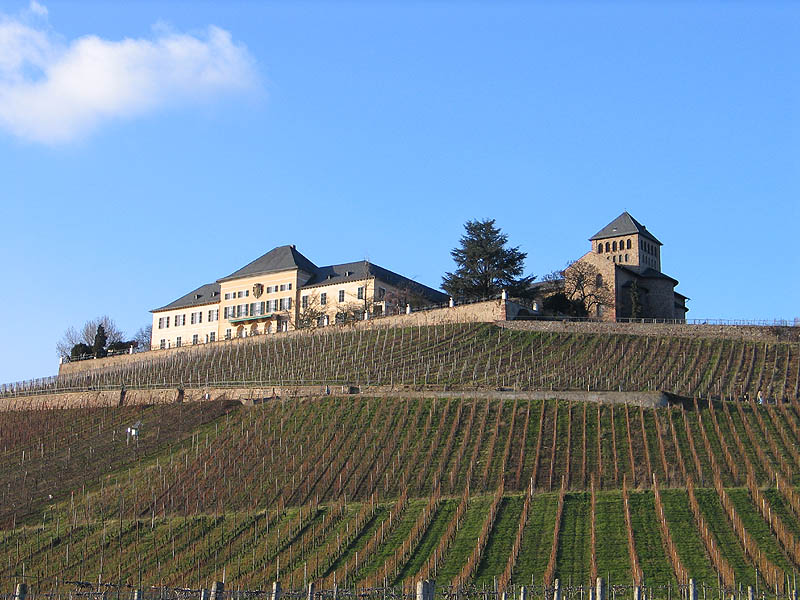|
Ingelheim
Ingelheim (), officially Ingelheim am Rhein (), is a town in the Mainz-Bingen Districts of Germany, district in the Rhineland-Palatinate state of Germany. The town sprawls along the Rhine's left bank. It has been Mainz-Bingen's district seat since 1996. From the later half of the 8th century, the Imperial Palace, Ingelheim, Ingelheim Imperial Palace, which served emperors and kings as a lodging and a ruling seat until the 11th century, was to be found here. Etymology The typically Rhenish Hesse, Rhenish-Hessian placename ending ''—heim'' might well go back to Franks, Frankish times, that is to say, likely as far back as the 5th or 6th century. Settlements or estates then took their lords’ names and were given this suffix, which means "home" in German language, German. The name is recorded in later documents as ''Ingilinhaim'', ''Ingilinheim'' (782), ''Ingilenhaim'', ''Engelheim'', ''Hengilonheim'', ''Engilonheim'' (822), ''Engilinheim'' (826), ''Hingilinheim'' (855), ''Ing ... [...More Info...] [...Related Items...] OR: [Wikipedia] [Google] [Baidu] [Amazon] |
Ingelheim Merian 1645
Ingelheim (), officially Ingelheim am Rhein (), is a town in the Mainz-Bingen district in the Rhineland-Palatinate state of Germany. The town sprawls along the Rhine's left bank. It has been Mainz-Bingen's district seat since 1996. From the later half of the 8th century, the Ingelheim Imperial Palace, which served emperors and kings as a lodging and a ruling seat until the 11th century, was to be found here. Etymology The typically Rhenish-Hessian placename ending ''—heim'' might well go back to Frankish times, that is to say, likely as far back as the 5th or 6th century. Settlements or estates then took their lords’ names and were given this suffix, which means "home" in German. The name is recorded in later documents as ''Ingilinhaim'', ''Ingilinheim'' (782), ''Ingilenhaim'', ''Engelheim'', ''Hengilonheim'', ''Engilonheim'' (822), ''Engilinheim'' (826), ''Hingilinheim'' (855), ''Ingilunheim'' (874), ''Ingulinheim'' (889), ''Ingelesheim'' (891), ''Ingelenheim'' (940), ' ... [...More Info...] [...Related Items...] OR: [Wikipedia] [Google] [Baidu] [Amazon] |
Imperial Palace, Ingelheim
The Ingelheim Imperial Palace () was an important imperial palace erected in the second half of the 8th century in Germany. It served kings of Francia and later Holy Roman Emperors and Kings as a residenz and place for governance until the 11th century. The former palace complex is located in the cadastral area of Nieder-Ingelheim, 15 km west of Mainz, in district "Im Saal". It is located at a slope with a view of the Rhine plains. Impressive remains of the buildings of the palace have been preserved above ground to this day. The greater part of the complex is located foundation under ground and archaeological excavations have been able to reconstruct the entire system of buildings. History The presence of the builder of the ''Kaiserpfalz'', Charlemagne, in Ingelheim is first documented in September 774. Since the end of 787 he stayed in Ingelheim again, but this time for much longer. He spent Christmas here and stayed over the winter without interruption until the m ... [...More Info...] [...Related Items...] OR: [Wikipedia] [Google] [Baidu] [Amazon] |
Schwabenheim An Der Selz
Schwabenheim an der Selz is an ''Ortsgemeinde'' – a municipality belonging to a ''Verbandsgemeinde'', a kind of collective municipality – in the Mainz-Bingen district in Rhineland-Palatinate, Germany. Geography Location The municipality lies in the north of Rhenish Hesse, south of Ingelheim on the east bank of the Selz. Neighbouring municipalities Clockwise from the north, these are Ingelheim am Rhein with its outlying centres of Großwinternheim and Wackernheim, Stadecken-Elsheim in the ''Verbandsgemeinde'' of Nieder-Olm and Bubenheim in the ''Verbandsgemeinde'' of Gau-Algesheim. History Origin of the name Schwabenheim * 11th century: From this time come documents that are known to refer to Schwabenheim. From this time forth, the place has been mentioned by the following names: * 1023 – ''Suabheim'' * 1051 – ''Suaveheim'' * 1140 – ''Suapeheim'' * 1200 – ''Suosabenheim'' * 1328 – ''Suabeheim'' * 1339 – ''Schwabeheim'' * 1424 – ''Schwabneheim'' * ... [...More Info...] [...Related Items...] OR: [Wikipedia] [Google] [Baidu] [Amazon] |
Gau-Algesheim
Gau-Algesheim is a town in the Mainz-Bingen district in Rhineland-Palatinate, Germany. It is the seat of the Gau-Algesheim (Verbandsgemeinde), ''Verbandsgemeinde'' of Gau-Algesheim, a kind of collective municipality. Geography Location Gau-Algesheim lies roughly 20 km west of Mainz and just under 3 km away from the Rhine on the edge of the ''Ingelheimer Rheinebene'' (“Ingelheim Rhine Plain”) on the terraces at the Rhenish Hesse West Plateau, into whose varied soil structure the “Geo-Ecological Teaching Path” on the Westerberg (Rheinhessen), Westerberg slopes allows a glimpse. Through the municipal area flows the Welzbach (Rhine), Welzbach. Neighbouring municipalities Clockwise from the north, these are Ingelheim am Rhein, Ingelheim, Appenheim, Ockenheim and Bingen am Rhein, Bingen. Constituent communities Gau-Algesheim's ''Ortsteil, Stadtteile'' are Gau-Algesheim and Laurenziberg. History In Ancient Rome, Roman times this was a border area, but alrea ... [...More Info...] [...Related Items...] OR: [Wikipedia] [Google] [Baidu] [Amazon] |
Wackernheim
Wackernheim is a former ''Ortsgemeinde'' – a municipality belonging to a ''Verbandsgemeinde'', a kind of collective municipality – in the Mainz-Bingen district in Rhineland-Palatinate, Germany. Since July 2019, it is part of the town Ingelheim am Rhein. It is home to the United States Army's McCully Barracks. Geography Location The municipality lies west of Mainz in a side valley of the Rhine between the Rabenkopf nature reserve, Layenhof and the Mainzer Berg (mountain). Until July 2019 Wackernheim belonged to the ''Verbandsgemeinde'' of Heidesheim am Rhein, whose seat was in the like-named municipality. History In 754, Wackernheim had its first documentary mention. Politics Municipal council The council is made up of 19 council members, counting the part-time mayor, with seats apportioned thus: (as at municipal election held on 13 June 2004) Town partnerships * Daix, Côte-d'Or, France * Roncà, Province of Verona, Veneto, Italy Coat of arms The mun ... [...More Info...] [...Related Items...] OR: [Wikipedia] [Google] [Baidu] [Amazon] |
Mainz-Bingen
Mainz-Bingen is a district (''Kreis'') in the east of Rhineland-Palatinate, Germany. Neighboring districts are (from north clockwise) Rheingau-Taunus, the district-free cities Wiesbaden and Mainz, the districts Groß-Gerau, Alzey-Worms, Bad Kreuznach, and Rhein-Hunsrück. History During the French occupation under Napoleon the district was part of the department of Mont-Tonnerre. After the Congress of Vienna, the area north of the Nahe river went to the Prussian Rhine province, the biggest part however became part of the Grand Duchy of Hesse and was called Rhenish Hesse. In 1835 the Mainz district was created when the province Rheinhessen was abolished. In 1852 the Oppenheim district was created, and took some of the area of the Mainz district; in 1938 this district was abolished again. The current area of the district was formed in 1969, when the districts of Mainz and Bingen were merged. Geography The main river in the district is the Rhine, which marks the border of the distr ... [...More Info...] [...Related Items...] OR: [Wikipedia] [Google] [Baidu] [Amazon] |
Oestrich-Winkel
Oestrich-Winkel () is a town with roughly 12,000 inhabitants in the Rheingau-Taunus-Kreis in the ''Regierungsbezirk'' of Darmstadt in Hesse, Germany. Geography Location Oestrich-Winkel, which culturally belongs to the Rheingau region, lies on the Rhine River, 19 km west-southwest of Wiesbaden and 17 km west of Mainz. It is, as a part of the Rheingau wine region, the largest winegrowing town of Hesse. The coordinates 50°N, 8°E lie right in the stadtteil of Winkel, whose name, coincidentally, is German for “angle”. Neighbouring municipalities Oestrich-Winkel borders in the north on the town of Lorch and the municipalities of Welterod (Rhein-Lahn-Kreis in Rhineland-Palatinate), Heidenrod and Schlangenbad; in the east on the town of Eltville; in the south, across the Rhine, on the town of Ingelheim (Mainz-Bingen district in Rhineland-Palatinate) and in the west on the town of Geisenheim. Territorial structure Oestrich-Winkel as a municipality consists of ... [...More Info...] [...Related Items...] OR: [Wikipedia] [Google] [Baidu] [Amazon] |
Geisenheim
Geisenheim is a town in the Rheingau-Taunus-Kreis in the ''Regierungsbezirk'' of Darmstadt (region), Darmstadt in Hessen, Germany, and is known as ''Weinstadt'' (“Wine Town”), ''Schulstadt'' (“School Town”), ''Domstadt'' (“Cathedral Town”) and ''Lindenstadt'' (“Linden Tree Town”). Geography Location Geisenheim lies on the Rhine’s right bank between Wiesbaden and Rüdesheim am Rhein, Rüdesheim, 3 km away to the west. Mainz lies 21 km away to the east. Neighbouring communities Geisenheim borders in the north on the town of Lorch, Hesse, Lorch, in the east on the town of Oestrich-Winkel, in the south on the towns of Ingelheim am Rhein, Ingelheim and Bingen am Rhein, Bingen (both in Mainz-Bingen in Rhineland-Palatinate) and in the west on the town of Rüdesheim am Rhein, Rüdesheim. Constituent communities The town of Geisenheim is divided into four ''Ortsteil, Stadtteile'': the main town (also called Geisenheim), Johannisberg (Grund, Berg, Schlo ... [...More Info...] [...Related Items...] OR: [Wikipedia] [Google] [Baidu] [Amazon] |
Rhenish Hesse
Rhenish Hesse or Rhine HesseDickinson, Robert E (1964). ''Germany: A regional and economic geography'' (2nd ed.). London: Methuen, p. 542. . (, ) is a region and a former government district () in the German state of Rhineland-Palatinate. It is made up of territories west of the Upper Rhine river that were part of the Grand Duchy of Hesse and its successor in the Weimar Republic, the People's State of Hesse from 1816 to 1945. The hilly countryside is largely devoted to vineyards, comprising the Rheinhessen wine region. Geography Rhine Hesse stretches from the Upper Rhine Plain on the west bank of the Rhine up to the Nahe and Alsenz rivers in the west and down to the mouth of the Isenach in the south. The region borders on the Rhineland in the northwest, on the Palatinate in the southwest, and on South Hesse beyond the Rhine. The Rhenish-Hessian Hills along the Selz river, also called the "land of the thousand hills", reach up to at the summit of the Kappelberg and about ... [...More Info...] [...Related Items...] OR: [Wikipedia] [Google] [Baidu] [Amazon] |
Rheingau
The Rheingau (; ) is a region on the northern side of the Rhine between the German towns of Wiesbaden and Lorch, Hesse, Lorch near Frankfurt, reaching from the Western Taunus to the Rhine. It is situated in the German state of Hesse and is part of the Rheingau-Taunus-Kreis districts of Germany, administrative district. It is famous for Rheingau wines, especially the "Rheingauer Riesling," and its many taverns. History The Rheingau was a ''Gau (country subdivision), Gau'' or county of the Frankish Empire, bordered by the Niddagau, the Maingau, the Oberrheingau, and the Lahngau; the counts of the Rheingau were known as Rhinegraves. The first Rhinegrave on record is Hatto VI, Rhinegrave, Hato VI (937–960).Rheingraf at ''Meyers Konversationslexikon'', 1888 Since the Ingelheim Imperial Palace was on the other bank of the Rhine, im ... [...More Info...] [...Related Items...] OR: [Wikipedia] [Google] [Baidu] [Amazon] |
Mainz
Mainz (; #Names and etymology, see below) is the capital and largest city of the German state of Rhineland-Palatinate, and with around 223,000 inhabitants, it is List of cities in Germany by population, Germany's 35th-largest city. It lies in the Frankfurt Rhine-Main, Rhine-Main Metropolitan Region—Germany's second-largest metropolitan region after Rhine-Ruhr—which also encompasses the cities of Frankfurt am Main, Wiesbaden, Darmstadt, Offenbach am Main, and Hanau. Mainz is located at the northern end of the Upper Rhine Plain, on the left bank of the Rhine. It is the largest city of Rhenish Hesse, a region of Rhineland-Palatinate that was historically part of Grand Duchy of Hesse, Hesse, and is Rheinhessen (wine region), one of Germany's most important wine regions because of its mild climate. Mainz is connected to Frankfurt am Main by the Rhine-Main S-Bahn rapid transit system. Before 1945, Mainz had six boroughs on the other side of the Rhine (see: :de:Rechtsrheinische St ... [...More Info...] [...Related Items...] OR: [Wikipedia] [Google] [Baidu] [Amazon] |



